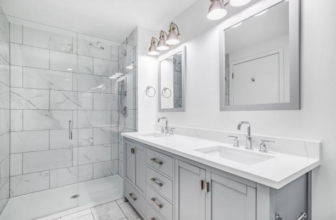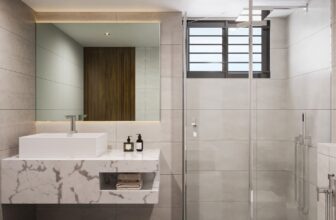8 Alternatives To Exhaust Fan in Bathroom
Having your bathroom in proper condition, meaning that it’s healthy, safe, and fresh, is not possible without proper ventilation.
Almost every time we visit a bathroom, even just to freshen up, we create humidity, not to mention the foul odor that is often left behind.
With no ventilation, the bathroom will quickly become smelly, humid, and generally unpleasant to be in.
But moisture can create even bigger problems, as it’s responsible for mold growth, ceiling damage, and can ruin walls and wooden fixtures you may have.
In most bathrooms, these issues are solved with an exhaust fan which works to reduce humidity and control bad smells.
However, some bathrooms don’t have an exhaust fan, but still, these problems need to be dealt with.
Below, I’ll suggest several solutions that can work as an alternative to exhaust fan in bathroom and can still make your time in there pleasant and enjoyable.
So, let’s dive in!
Table of Contents
8 Alternatives To Exhaust Fan in Bathroom
In bathrooms, exhaust fans are probably the most efficient way to prevent bad smells, limit bacteria growth and mold development, reduce damage to walls, ceilings, and fixtures, as well as increase the level of comfort and prevent potential accidents.
However, if you live in a house that doesn’t have an exhaust fan in the bathroom, you still need to find a way to ensure proper ventilation for all the reasons mentioned above.
So, if you’re looking for an alternative to exhaust fan in bathroom, here is a short rundown of potential solutions.
Ductless Fan
If you don’t have an exhaust fan installed in your bathroom, you can still use some other type of fan to increase air circulation and help dehumidify the space faster.
One of the possible solutions is a ductless fan that doesn’t require the complex installation of its exhaust counterpart but still can do the job.
As implied by its name, ductless fan doesn’t require creating ductwork routes or cutting holes in roofs or walls.
It’s very simple to install, as all you have to do is attach it to the wall or ceiling.
As ductless fans use charcoal filters, they will not only reduce humidity in the bathroom but also help you get rid of unpleasant odors.
However, be aware that they will only be effective in smaller bathrooms.
Ceiling Fan
Another alternative to exhaust fan in bathroom is the installment of a ceiling fan, similar to the ones you may already have in the living room or bedroom.
It can be a very effective and quick way to remove bad smells and humid air from your bathroom.
In addition, a ceiling fan will also help decrease the temperature in the bathroom and make it more pleasant to spend time in, especially if you enjoy hot showers and baths or live in an area with a particularly warm climate.
It’s important to note that not all ceiling fans are suitable for bathrooms.
You’ll need to install one that’s damp-rated, meaning that they are moist-resistant, rust-proof, and can operate in humid areas.
Also, ceiling fans work best in bathrooms with openable windows, as they can circulate the air more efficiently and vent it out the window.
Household Fan
If there are no other options, a regular household fan, that you use elsewhere in the house, can also serve as an alternative for the bathroom exhaust fan.
In a pinch, any type of household fan will do, including oscillating or box fans.
The only condition is that it has enough power, as smaller household fans would not be very effective in dealing with bathroom humidity and smells.
Similar to a ceiling fan, a household fan will work best in combination with pen windows, if you even have windows in your bathroom.
This type of fan is particularly practical as it can still serve its primary purpose elsewhere and only be used in the bathroom only after you take a bath or shower.
Of course, due to the electrical hazards, be extra careful when using these fans in the bathroom and make sure they don’t come in contact with water.
Air Conditioner
For the lack of a better option, you can also install an air conditioner in your bathroom to reduce humidity and improve ventilation.
This is not the cheapest option, but it’s rather efficient.
An air conditioner will improve air circulation, prevent the buildup of excess moisture, and help eliminate unpleasant odors.
The Ac unit will absorb the humid air and drain out the excess moisture, and, at the same time, release fresh and cool air into the bathroom.
Besides the cost, another potential downside of this alternative to the exhaust fan is that it will likely require a professional installation.
All this makes this option rather impractical for smaller bathrooms.
Still, once installed, the air conditioner will serve you for a long time and dramatically improve the air quality in your bathroom.
Dehumidifier
If you have a dehumidifier, you can also use it to cover some of the tasks normally performed by a bathroom exhaust fan.
Dehumidifiers are very useful for these purposes as they work to reduce the humidity in the air and maintain it at an acceptable level, which is key in keeping your bathroom clean and healthy.
For best results, make sure to use the humidifier designed for the specific square footage of your bathroom.
This option even has a few advantages over using the exhaust fan.
Firstly, it requires no installation, all you have to do is bring the dehumidifier into the bathroom and plug it in.
Also, it has automatic sensors that will turn it on whenever the humidity is above the set level.
The downside is that if you keep it on all the time, you’ll have to empty the condensed water rather frequently.
Dehumidifying Crystals
Dehumidifying crystals will probably not be as efficient in reducing bathroom humidity as an exhaust fan or some of the options described above, but can still help absorb some of the moisture.
Essentially, these crystals are hygroscopic salts that have the ability to absorb humidity from the air around them, while keeping the environment safe and avoiding damage to clothes or plants.
They typically come in a package that includes a small container used to collect the excess vapor.
As crystals absorb moisture from the air, they turn into a solid mass and as they are exposed to more water, they start to dissolve, forming a brine and emptying into the container.
Once all the crystals are dissolved, you’ll have to empty the container into the toilet and refill the bucket with new crystals.
Some crystals also work to eliminate any unpleasant odors caused by the dampness in the bathroom.
Windows
The simplest way to get rid of some of the excess moisture and odors from the bathroom if you don’t have an exhaust fan is to open the windows.
In smaller bathrooms, opening the windows for a few hours can fully ventilate the entire room.
If you live in an area with a warmer climate, you can even keep windows open all the time.
Of course, this is only possible if you have openable windows in your bathroom. If not, you can install them to improve air circulation and ventilation,
However, this won’t be possible in some bathrooms, depending on the architecture of the house.
Plus, installing new windows is the most expensive and most complex way to deal with bathroom humidity.
Plants
Adding certain plants to your bathroom is another practical, but often overlooked, way to make up for some of the benefits typically provided by an exhaust fan.
Several plant species, such as Boston Fern, English Ivy, Green Pothos, or Epiphyte Orchid, are known to draw moisture from the air, creating a more pleasant environment in the bathroom.
Furthermore, these plants will reduce carbon dioxide levels, freshen the air, and add some aesthetic appeal to the bathroom.
While they won’t be able to reduce the humidity to the same level as an exhaust fan, these plants can still be rather useful in smaller bathrooms.
Still, like all plants, they will require some care, so look to choose species that won’t require much watering or other types of maintenance.
Plants that enjoy particularly wet soil, can do more damage than good, as they will only add moisture to the bathroom air.
Conclusion
Even with all the alternatives mentioned above, an exhaust fan remains the best way to keep your bathroom fresh, clean, and safe.
However, these options still can provide some results, especially when combined with some common-sense actions to keep the air in the bathroom clean and dry.
This includes keeping the door open when possible, wiping down condensation from shower cabin walls, tiles, or mirrors, and taking shorter and cooler showers.
Certainly, using one of the above methods is better than doing nothing at all, as that is a certain way to make your bathroom smelly and humid, as well as ruin the walls and ceiling by allowing the mold to develop.
If, for whatever reason, you can’t install an exhaust fan, it’s best that you try and combine a couple of these alternatives until you find the one that works best for your bathroom.



















































































